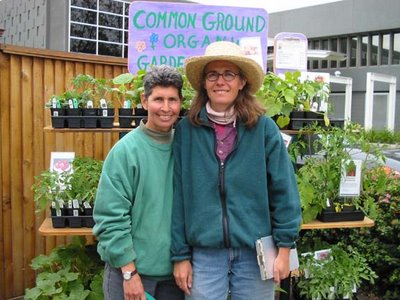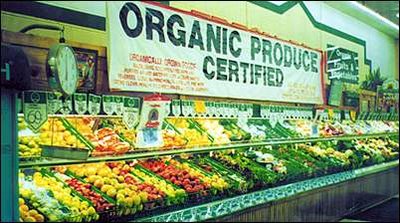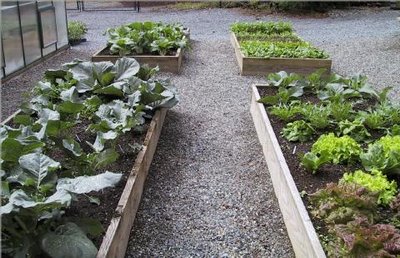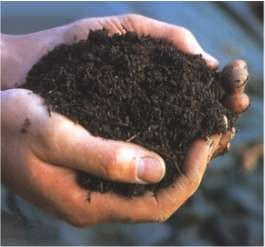skip to main |
skip to sidebar
 PALO ALTO, CALIFORNIA - Whether it's gardening classes, tools or supplies, Common Ground Organic Garden Supply and Education Center in Palo Alto has filled the bill for gardeners and mini-farmers for 34 years.
PALO ALTO, CALIFORNIA - Whether it's gardening classes, tools or supplies, Common Ground Organic Garden Supply and Education Center in Palo Alto has filled the bill for gardeners and mini-farmers for 34 years.
John Jeavons is executive director and a founder of Ecology Action of the Midpeninsula, a nonprofit environmental research and education organization that started in Palo Alto and later moved to Willits (Mendocino County).
Common Ground is one of Ecology Action's projects.
Ecology Action began in 1970 when a group of Palo Alto residents got together to start a recycling program in the city, said Patricia Becker, manager of the Common Ground center.
After the city took over the recycling program, Becker said, Ecology Action started four more projects: a bicycle workshop that also promoted bicycle lanes in Palo Alto, the Common Ground education center, the Common Ground supply center and the half-acre Common Ground research, demonstration and biointensive garden at Syntex Corp. in Palo Alto.
The bicycle workshop evolved into the independent Wheelsmith bicycle repair shop and then into Wheelsmith Fabrications Inc., a maker of lightweight bicycle wheels that moved to Big Timber, Mont.
The garden was discontinued in 1981, a year before Ecology Action moved to Willits, where it has demonstration gardens and promotes biointensive mini-farming throughout the world.
Using organic and sustainable techniques developed by the late English horticulturist Alan Chadwick, biointensive practices emphasize ways to grow enough food for a family of four on much less land than required by conventional agriculture.
Those techniques stress seven factors used in combination:
-- Double-dug raised beds.
-- Composting.
-- Intensive planting.
-- Companion planting -- plants that do well together or that attract or repel insects.
-- Carbon farming -- feed and grain crops such as corn, wheat, millet, amaranth and oats that produce a large number of calories and make good compost.
-- Calorie farming -- high-calorie crops such as potatoes, sweet potatoes and parsnips.
-- Open-pollinated seeds rather than hybrids.
Jeavons describes these techniques in his "How to Grow More Vegetables (and Fruits, Nuts, Berries, Grains and Other Crops) Than You Ever Thought Possible on Less Land Than You Can Imagine." Originally written in 1974, the book will come out in a seventh edition from Ten Speed Press this month.
Becker worked as Common Ground's class coordinator for four years. At that time, the center was at 225 El Camino Real. She became the center's manager in 2000 and supervised its move to 559 College Ave. in September 2001.
Originally from Pittsburgh, Becker became seriously interested in macrobiotics in her late 20s. Macrobiotics is a dietary approach that stresses whole grains, fresh vegetables, beans and other "seasonal, local and organic" foods, she said.
She came to California in 1984 to work as a macrobiotic chef in a Hillsborough couple's home. Since then, her career has taken her to such places as Harbin Hot Springs in Lake County and Hidden Villa Organic Farm and Wilderness Preserve in Los Altos Hills.
She describes Common Ground as follows: "It's community; it's gardening; it's education."
"We want to have what people need" for gardening. She also wants it to carry locally made items such as jams, honey, soaps and crafts.
In addition, the center sells high-quality garden tools. It has a lending library for members (basic membership costs $25 a year) and a reference library for in-store reading.
Customers can buy more than 500 varieties of seeds in jars or packets, vegetable and herb seedlings, native plants, organic fertilizers and soil conditioners, and natural pest control products.
Common Ground also offers classes ranging from an introduction to permaculture to composting techniques and designing sustainable landscapes. A complete schedule is at commongroundinpaloalto.org.
Harking back to its roots, the center plans to develop a garden on land offered by the Palo Alto Christian Reformed Church on Arastradero Road, which will be used to demonstrate intensive gardening methods and to raise seedlings to sell at the center. It also will be an outdoor classroom.
Becker expects planting to start by the end of the year. The center is still looking for a sponsor to provide funds to hire a full- or three-quarter-time gardener, she said.
from The San Francisco Chronicle
 Head to the grocery store these days, and almost everything on your shopping list has an organic equivalent. You can buy organic cereal, soup, chicken, cheese, and yes, even organic burgers.
Head to the grocery store these days, and almost everything on your shopping list has an organic equivalent. You can buy organic cereal, soup, chicken, cheese, and yes, even organic burgers.
Organic foods, including produce, meats, grains, and ingredients used to make various products, must be grown without the use of potentially harmful pesticides, chemical fertilizers, antibiotics, or growth hormones. We get healthier food when we eat organic. There are studies that suggest organic produce has higher nutrient levels and studies connecting health risks to the hormones and antibiotics” used in conventional animal products. Some nutritionists argue the differences are negligible, but eating an organic diet is greater than the sum of its parts, because like a savings account, the benefits accumulate over time.
Still, even with the introduction of lower-cost supermarket brands, conventional foods have one irresistibly attractive quality: price. Organic fruits and vegetables typically cost 10 to 30 percent more, and frozen produce, meats, eggs, milk, and processed foods like cereals, soups, and salad dressings run 50 to 100 percent more. So should a runner always shell out the extra cash for the healthier stuff?
Smart Shopping
There are clear differences among fruits and vegetables in their loads of pesticides. Some make sense to buy organic; others don’t matter as much By eating the organic versions of the dirty dozen, you can reduce your exposure to contaminants by 90 percent. If your budget or options are limited, don’t feel bad forgoing organic food. The reason for the difference in pesticide levels varies from crop to crop; some foods require more pesticides than others, and some have their own protective shell, like the skin of a mango or a banana peel. And buy conventional, too, if you can’t find or afford organic produce. Eating fruits and vegetables for the multiple nutrients they provide is the more important thing. The bottom line is that some foods expose you to more contaminants than others. If you can afford to buy organic all the time, it’s better for you-and the planet.
Organic Shopping Guide
What does the label mean? The word organic can be used for both domestic and imported foods. Here’s what the other labels mean:
100 per cent Organic: All ingredients must be organic
Organic: Guarantees 95 per cent of the ingredients are organic
Made with organic ingredients: At least 70 per cent of the contents are organic
from Afternoon Dispatch & Courier
 UNITED KINGDOM - Sales of organic produce in the UK have jumped 30% in a year and are now worth £1.6bn annually.
UNITED KINGDOM - Sales of organic produce in the UK have jumped 30% in a year and are now worth £1.6bn annually.
All the leading supermarkets have expanded their range of organic food rapidly in the last year and report dramatic growth in demand. Supermarkets accounted for £1.2bn of the total market for organic produce in 2005.
Sainsbury's and Waitrose were earliest to exploit demand but growth is now also strong in supermarkets with less affluent customers. Sainsbury's, Tesco and Waitrose all say they have seen growth in organic sales of around 20% year on year.
Tesco said that its organic fruit and vegetable sales were growing by 70%. One in three of its shoppers now buy some organic produce, according to a spokeswoman. Asda said it was aiming to sell 1,000 organic lines by Christmas, doubling the size of its range as it tries to catch up with the market leaders.
Half of shoppers in the most disadvantaged socio-economic groups now buy some organic produce, according to the Soil Association's annual assessment.
But as organic fortnight begins today, the success story comes with a warning. The organic farmers organisation, the Soil Association, says that supermarkets rushing to increase their share of the sector are making it harder for pioneeers of the movement to survive. Patrick Holden, director of the Soil Association, said: "A significant number of small organic businesses have suffered from supermarkets switching suppliers or abandoning a brand in favour of their own label production. There is a tyranny about own label products that allows supermarkets to abuse small producers. Customers need to insist on branded products."
Mr Holden said he knew of at least two suppliers who had been threatened with their products being delisted by a supermarket if they refused to switch their production to the supermarkets' own label.
The Guardian has spoken to several organic companies who confirm that they have been under pressure from major retailers but fear losing their business altogether if they are identified. The problems they report range from supermarkets selling their own label organic food at an unrealistic subsidised price to capture market share, to branded recipes being copied for own label lines and prices paid to producers being driven down below the cost of production.
Leading retailers deny that they are squeezing brand names out of the market. Asda, which says its organic sector has grown 30% year on year, said the increase had mostly been driven by branded products, since it was quicker to build on them than create new own label products. Tesco and Sainsbury's also said they worked closely with organic suppliers.
Both Tesco and Sainsbury's have recently announced that they will be running pilot schemes to deliver boxes of fruit and vegetables to individual houses. "In the lasts three years, we've seen a mindset change in people's attitudes towards food," said Alison Austin, head of sustainability at Sainsbury's.
The problem now was meeting demand. Organic meat was in short supply, and a shortage of forage meant supplies of British organic milk were unlikely to be sufficient come winter, she added.
from The Guardian Unlimited
 SAN BERNARDINO, CALIFORNIA - In the Inland Empire we can commence fall planting now through November. It is time to plant winter vegetables, bulbs, perennials, trees, shrubs and annuals.
SAN BERNARDINO, CALIFORNIA - In the Inland Empire we can commence fall planting now through November. It is time to plant winter vegetables, bulbs, perennials, trees, shrubs and annuals.
While it is still too hot to plant some bulb and annuals, take time out to make a list of the things that you want to accomplish before fallsets in. What new plants you want to plant, which ones need dividing,which area needs fertilizing, which garden bed needs to be prepared and enriched. Do you need to make some raised beds this year since theknees are not working as well as they did last year?
Prepare for fall planting toward the end of September. Fall is theperfect planting time as the weather promotes root growth. There is still time to plant summer annuals such as dwarf zinnia and marigolds, vinca, impatiens, petunias, and phlox. Perennial plants that can beplanted include carnations, sweet William, ageratum, lobelia, alyssum, columbine, lupine and hollyhock. The weather is still warm enough topromote rapid root growth before frost sets in.
Seeds of annuals and perennials can be planted in sterile soil incontainers while it is still hot. They will be ready to transplantwhen the weather is cooler. The container will help to keep soil fungus from attacking and killing the seedlings. If you decide to plant the cool-weather plants in your garden now, instead of waiting for cooler weather, be certain to protect the plants with some shade and water them faithfully.
Check your overgrown perennials such as agapanthus, columbines, calla and canna lilies, coral bells, daylilies, gazanias, geum, herbs, iris (replant in October), penstemon, phlox, Shasta daisy, etc., for dividing and replanting.
The following seeds can be sown now if you have prepared the ground with mulch and begin good watering practices: California and Mexican poppies, African daisies, annual candytuft, bachelor buttons, forget-me-nots (shade), larkspur, linaria, nemesia, sweet Williams, and winter flowering sweet peas. Spring flowering sweet peas can be planted in October through November. If you have an area for wildflowers, use this month to clear it of weeds so you can strew wild flower seeds after the first rain.
Other flower seeds that can be planted include ornamental cabbage, calendula, columbine, companula, coreopsis, cosmos, delphinium, foxglove, hollyhock, Johnny jump up, mimulus, nasturtium, pansy, penstemon, phlox, petunia, poppies (all varieties), salvia, snapdragon, and statice.
September continues the season for making cuttings and propagating fuchsias, geraniums, impatiens and other plants that could perish in a frost. Protect your cuttings from the sun and then the cold.
Roots and bulbs include artichoke, asparagus, horseradish, onion, garlic, shallot, and other vegetables as they become available at the stores.
Bulbs, corms and tubers will begin to appear on the shelves this month.It is a good idea to buy these now while they are fresh and large sizes are in good supply. Don't plant now; store the bulbs in a cool dry place for planting in October. Tulips, hyacinths and crocus do best if they are stored in the refrigerator for four to six weeks at 40 degrees before planting in November. November is the month to plant ranunculus; more about that next month.
After the leaves of daffodil and narcissus bulbs, gladiolus corms, andoriental lilies leaves have yellowed, they may be dug, cleaned and dried in the sun for a week. Store in a cool dry shady place until replanting season resumes in January.
Pruning requirements for September are usually limited to thinning outshrub where there is a risk of wind damage. Staking small trees that are vulnerable to winds is advisable also check trees to make certain the stakes are not too tight. Stake and tie chrysanthemum plants to prevent drooping and breaking. This is a good month for general cleanup and spraying with a horticultural spray.
Cut off dead blooms of roses and annuals to promote fall blooms. Cut back straggly petunias to two growth nodes beyond the old hardwood and feed them for more fall color.
Keep the ground moist, don't let the soil dry out. As it gets cooler,the soil still needs to have moisture for healthy plants. Don't forget to fill the bird baths every week this month with fresh water (mosquitoes breed in stale water). Withhold water from your lilac bushes from now until January to start their dormant period. Gradually reduce watering of your pomegranate bush to reduce fruit splitting.
September is a good time to fertilize fall blooming plants, such as roses, chrysanthemums and annuals. This is the last chance to feed citrus so that new growth will harden before cold weather sets in. Add iron chelates to plants which show signs of yellowing foliage, this includes azaleas.
Autumn vegetable seeds to start include beets, Brussels sprouts, carrots, cabbage, cauliflower, celery, lettuce, kohlrabi, leek, mesclun,onions (short day types), parsley, sugar peas, turnips, radishes,spinach, Swiss chard and turnips.
Preparation of lawns for reseeding can be done now, but cool weathergrasses should be planted in October or November when the weatherstabilizes. You can start lowering your lawn mower now for the winter.Wait until October to fertilize.
Container pots with spring and summer plants should be checked to see if they need to be replaced with cool-weather varieties such aschrysanthemums. Choose plants with interesting and intense foliage color and plant with annuals that will bloom later in the season.Existing containers need to be kept moist -- use a slow drip method (if the plant's root ball has dried out, it will not absorb water).
Clean up under azalea and camellia plants to prevent disease. Water shallow-rooted plants, these include tropical ferns, fuchsias, and hydrangeas.
Start collecting fall leaves, spent summer vegetables, annuals,perennials, and small shrubbery for the compost pile, compost will enhance next year's soil.
When planting young plants, control snails and slugs as they are just waiting for their next succulent meal.
from The San Bernardino Sun
 FLORIDA - Whether you're an apartment-dwelling window box gardener or a homeowner with a sizable spread, composting is a simple operation that will provide a bounty for your plants while helping cut down on landfill waste.
FLORIDA - Whether you're an apartment-dwelling window box gardener or a homeowner with a sizable spread, composting is a simple operation that will provide a bounty for your plants while helping cut down on landfill waste.
What is compost? Basically, it is organic matter that has been broken down by the action of insects and microorganisms into a rich substance that loosens soil, improves moisture retention and provides a tremendous host of nutritional benefits. Frequently, compost gardeners will find that they no longer need to buy chemical fertilizers and soil amendments.
How you compost will depend on your needs and your space availability. For apartment gardeners with a small patio, there are small barrel-type composters available at most garden centers and online. They usually consist of a small metal or plastic barrel with a hatch and a crank for turning the contents. They will turn out a batch of perfectly finished compost in a very short time.
For those you with a yard, the options are far more numerous. You can construct a "free-form" heap, with your items piled up loosely, although they don't work as efficiently and can be difficult to keep weed-free. The cheapest route, and the one most-used by hardcore composters, is the chicken-wire enclosure, using either 3- or 4-foot wire to make a circular enclosure of roughly the same diameter.
If you have wooden pallets, they can be nailed together to make an outstanding heap. Use heavy-duty hinges on one side to make it easy to open for turning and emptying.
Basically, any material that can be used to build a round or square enclosure can be a compost heap. The important thing is what goes into the enclosure ... namely just about everything. Grass clippings, leaves, plant trimmings and other non-weed yard waste is a good foundation, but don't forget about your kitchen. If you're a coffee drinker, your grounds (filter, too!) should go into the heap. They'll provide moisture and a great source of trace minerals. Making a salad? Put those trimmings, stems and skins into the heap. Even your breakfast-time eggshells make great compost, adding more minerals to the mixture. Anything organic can go in, but avoid meat and bones, as they will attract pests, not to mention the stink. You want a compost heap, not a junk yard.
As far as maintenance goes, you can do as much or as little as your schedule allows. The more often you turn the heap, the faster it will break down and provide you with your end result. I tend to let my three heaps fill, turning them occasionally, all during the spring and summer, then break them open in the fall and winter, when it's time to work the flower beds in preparation for spring planting.
Keep the heap moist, although if you have an open-topped heap in an average climate, Mother Nature should take care of that fairly well. Again, the more attention you pay to proper moisture levels, the faster you'll get your finished product.
When you do "harvest" your compost, be sure and save a couple of bucketfuls to use as "starter" for the next go-round. That will provide a dose of the microorganisms and bacteria that dig in and start munching on your raw materials.
And where can you use your black gold? Anything green and growing will benefit from a dose of compost. For new plantings, use one part compost to four parts soil. For existing plants, in pots or gardens, gently work a layer of compost into the top layer of soil around the base of the plant. You can even spread it in your yard by hand or with a broadcast spreader to make your grass the envy of the neighborhood and help cut down on your watering.
One final tip for those of you using traditional on-ground heaps: Every couple of years, change where they are placed. Plant pumpkins in the old spots. You'll grow the biggest jack-o'-lanterns ever!
from NBC6
 PALO ALTO, CALIFORNIA - Whether it's gardening classes, tools or supplies, Common Ground Organic Garden Supply and Education Center in Palo Alto has filled the bill for gardeners and mini-farmers for 34 years.
PALO ALTO, CALIFORNIA - Whether it's gardening classes, tools or supplies, Common Ground Organic Garden Supply and Education Center in Palo Alto has filled the bill for gardeners and mini-farmers for 34 years.


